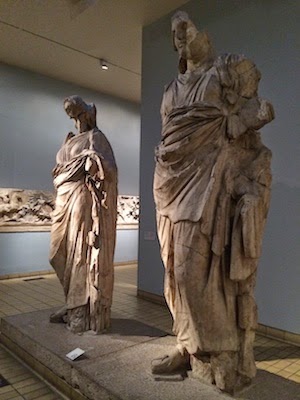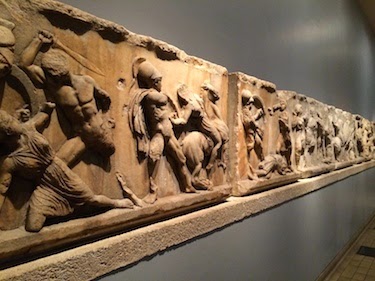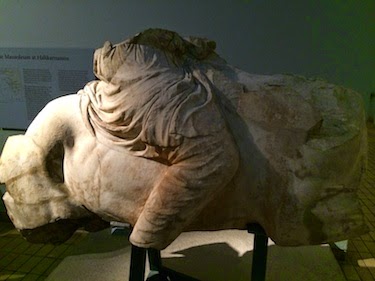 |
| Statues from the Mausoleum of Halicarnassus, At the British Museum in London |
We didn’t mean to sound too critical in our blog on the British Museum of the fact that artifacts from around the world have found their way into this huge collection in London. It’s a reflection of both Britain’s history as a global empire and the old practices of “grab, pack, and take” when it comes to archaeological artifacts. Fortunately, today’s perspectives on history and archaeology are a bit more reasoned.
Still, it was curious and interesting, just by no means surprising, to find more of the Mausoleum of Halicarnassus at the British Museum in London than we found at the actual site of this wonder of the ancient world in Bodrum, Turkey. Had we not actually walked around the site in Turkey a few weeks before, we might have walked past these artifacts on display in London; they are, after all, a little out of the way (many of these pieces are displayed in–effectively–a basement, probably visited only by people like us who specifically go down there to view pieces from the mausoleum). As we stood looking at one artifact, we met and struck up a conversation with another traveling couple from Vermont: we pointed out on a map of Turkey where the mausoleum site can be found. They commented how neat it would have been to see it, but we pointed out that more of it was actually right in front of them.
How exactly did these pieces come to London? If you recall from our blogs on Bodrum, this city that used to be named Halicarnassus was a stopover for crusaders coming and going to the Holy Land. This, in fact, is the origin of Bodrum’s Crusader Castle. That castle was built partly using stones and materials taken from the collapsed ruins of the Mausoleum across town. The artisanal pieces–statuary, friezes, etc.–were either cast aside as unusable in constructing a castle, were carried to the castle for decoration there, or were taken back to Western Europe then. Many were simply lost to history, and many may have been destroyed. Some of those that decorated the castle were taken to London through the centuries, and some that found their way into Western European gardens and castles sometimes got sent on to London, where they can be found today.
So this blog is a bit of a follow up to that original blog on this one wonder of the ancient world. Being able to admire, up close, the artisanship that used to adorn the ancient Mausoleum helped us to better appreciate what the original wonder was actually like. And for that–having these pieces on display, even if in a basement, instead of locked away in a warehouse–we thank the British Museum.
 |
| A Statue Believed to be of Mausolus Himself |
 |
| A Lion Originally from the Mausoleum’s Roofline |
 |
| A Horse Originally from the Mausoleum’s Peak |
 |
| Lapiths Fighting Drunken Centaurs, from the Mausoleum’s Base |
 |
| A Lion from a Hunting Scene Originally Near the Mausoleum’s Base |
 |
| A Horse Bearing a Disembodied Rider, Originally from Around the Mausoleum’s Base |






